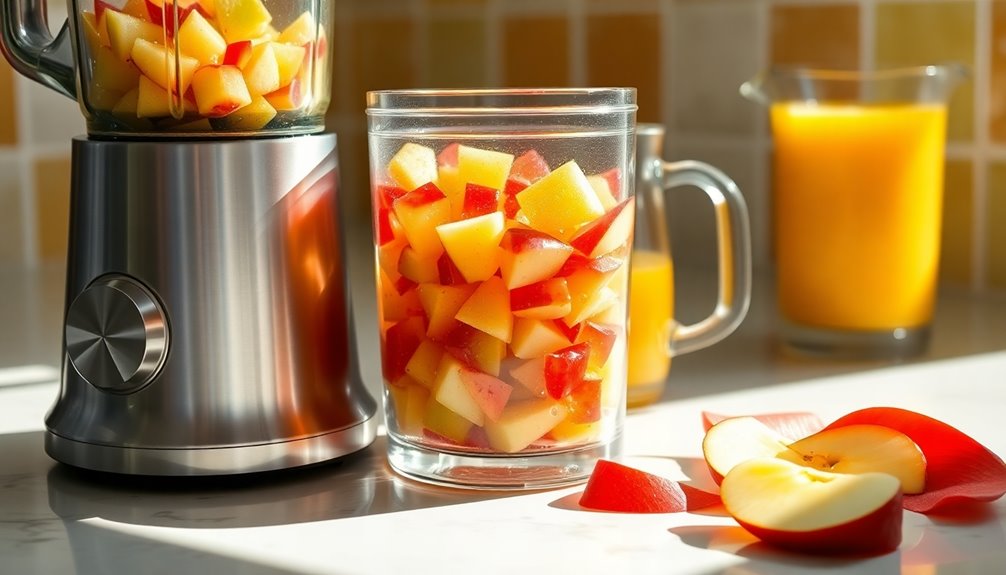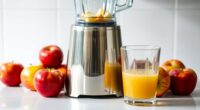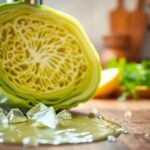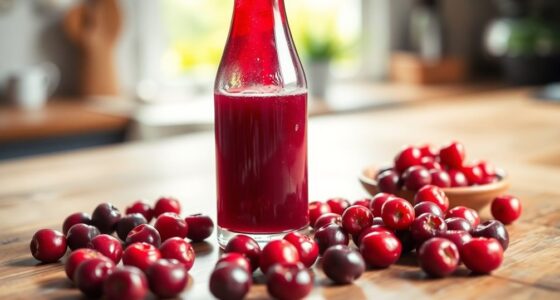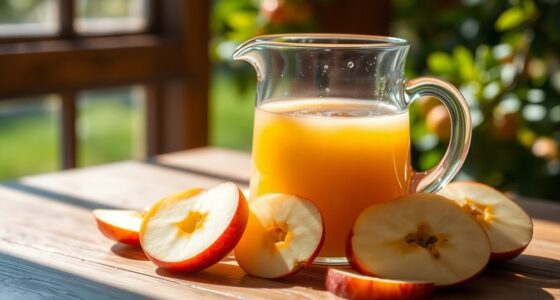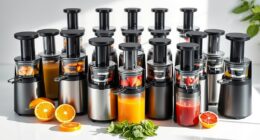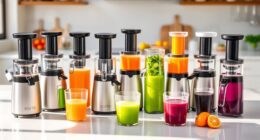To make apple juice with a blender, start by washing 2-3 medium-sized apples and chopping them into chunks. If you want a smoother texture, peel them first. Blend the apple chunks with a little water on high until smooth. Then, pour the mixture through a fine mesh sieve to separate the juice from the pulp. You can enhance the flavor by adding lemon juice or spices like cinnamon. There's much more to explore about perfecting your homemade juice!
Key Takeaways
- Wash and core 2-3 medium-sized apples, then chop them into chunks for blending.
- Blend the apple chunks with optional water and lemon juice until smooth.
- Pour the blended mixture through a fine mesh sieve to separate juice from pulp.
- Adjust flavor by adding spices like cinnamon or selecting sweet/tart apple varieties.
- Enjoy your homemade apple juice, rich in nutrients and free from preservatives.
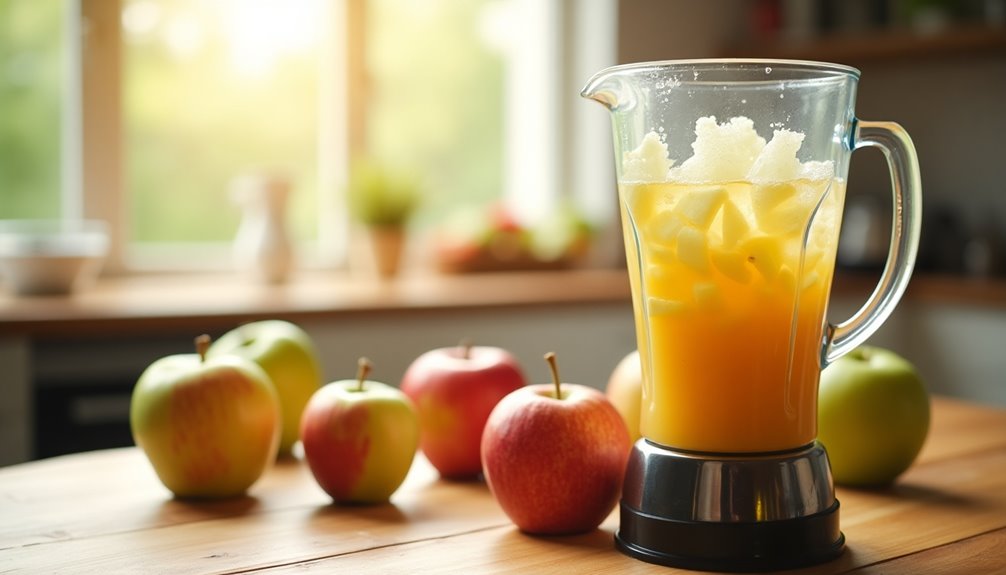
Making apple juice with a blender is easier than you might think. You don't need any fancy equipment or complicated processes to whip up a delicious batch of homemade fresh apple juice. With just a few steps and some fresh apples, you can enjoy a refreshing drink that's packed with flavor and nutrients. Let's dive into the simple instructions to make your own juice right in your kitchen.
Start by gathering your ingredients. You'll need 2-3 medium-sized apples, which can be any variety you prefer. For a well-rounded apple flavor, consider mixing sweet apples like Gala or Fuji with a tart variety like Granny Smith or Pink Lady. This combination will give your juice a delightful balance that's sure to please your taste buds.
Wash the apples thoroughly and, if you'd like, peel them. However, keeping the skin on can add extra nutrients and flavor to your juice. Core the apples, chop them into chunks, and you're ready to blend.
Now, it's time to blend the apples. Place the chopped apple chunks into the blender and add about 1/4 to 1/2 cup of water. The water helps to create a smoother consistency, so adjust the amount based on how thick or thin you like your juice. Blend the apples on high until the mixture is smooth and well-combined. You should see a vibrant mixture that's bursting with the natural sweetness of the apples.
Once your mixture is blended, it's time to separate the juice from the pulp. Grab a fine mesh sieve or some cheesecloth and place it over a bowl or pitcher. Pour the blended mixture into the sieve, allowing the juice to flow through while catching the pulp. You should end up with about one cup of fresh apple juice from your apples.
If you like your juice a bit tangy, adding 2 tablespoons of lemon juice during the blending process can enhance the overall flavor.
For an extra touch, consider sprinkling in some spices like cinnamon. This can elevate your fresh apple juice, giving it a cozy, warm flavor that's perfect for any season.
One of the best things about making homemade apple juice is that you're in control. You can adjust the sweetness and tartness based on the apples you choose. Plus, homemade apple juice is free from preservatives and retains more nutrients compared to store-bought versions. You get a refreshing drink that's not only delicious but also healthier for you and your family.
Frequently Asked Questions
How to Make Apple Juice From a Blender?
To make apple juice from a blender, start by washing and chopping 2-3 apples, removing the core and seeds. Once the apples are prepared, place them into the blender and add a cup of water to help with the blending process. Secure the lid and blend on high until the mixture reaches a smooth consistency. If you’re wondering how to blend apples for juice, simply strain the blended mixture through a fine mesh sieve or cheesecloth to separate the juice from the pulp, and enjoy your fresh apple juice!
You can peel them if you prefer. Blend the apple chunks with 1/4 to 1/2 cup of water on high speed until smooth, which takes about a minute.
Then, strain the mixture through a fine mesh sieve or cheesecloth to separate the juice from the pulp for a refreshing drink.
Enjoy your homemade juice!
Can You Make Juice With Just a Blender?
You know what they say, "Where there's a will, there's a way."
Yes, you can make juice with just a blender! Simply chop your desired fruit, blend it with a bit of water, and then strain the mixture to separate the juice from the pulp.
This method not only saves you money but also keeps more nutrients, including fiber. Plus, you can customize the flavor by mixing different fruits or adjusting the sweetness!
How Do You Make Homemade Apple Juice?
Making homemade apple juice is simple!
First, wash and chop 2-3 apples into smaller pieces. Blend the apple chunks with a bit of water until you get a smooth mixture.
Next, strain it through a fine mesh sieve or cheesecloth to separate the juice from the pulp. If you want, add flavors like lemon juice or cinnamon.
Finally, store your fresh juice in the fridge for 1-2 days to enjoy!
Can You Put a Whole Apple in a Blender?
Imagine trying to fit a whole watermelon into a tiny car; it just won't work. Similarly, you can't put a whole apple in a blender. The size and hardness could damage the blades, leaving you with a mess instead of juice.
Instead, core and chop the apple into smaller pieces. This way, you'll extract more juice and improve the texture. Plus, always wash them first to get rid of any unwanted residues.
Conclusion
Now that you know how to make fresh apple juice with a blender, you can enjoy a delicious and healthy drink anytime. Did you know that one medium apple contains about 4 grams of fiber? That's not just refreshing; it's also beneficial for your digestion! So, grab some apples, blend away, and savor the taste of homemade juice. You'll impress your friends and family while boosting your health with every sip!
Cindy thoroughly researches juicing trends, techniques, and recipes to provide readers with practical advice and inspiration. Her writing style is accessible, engaging, and designed to make complex concepts easy to understand. Cindy’s dedication to promoting the advantages of juicing shines through her work, empowering readers to make positive changes in their lives through the simple act of juicing.

